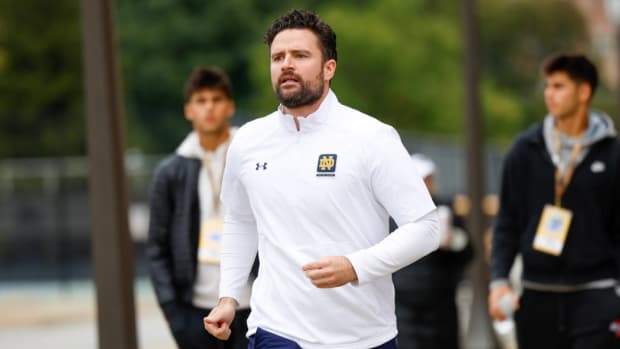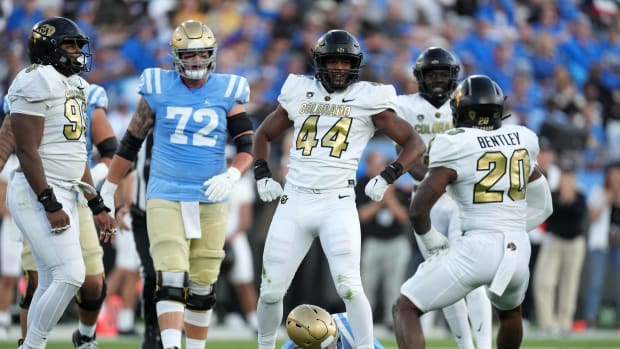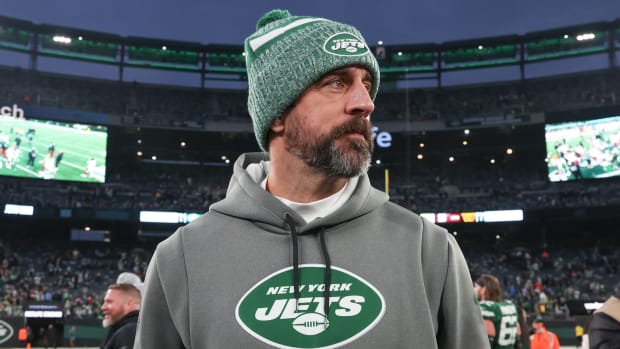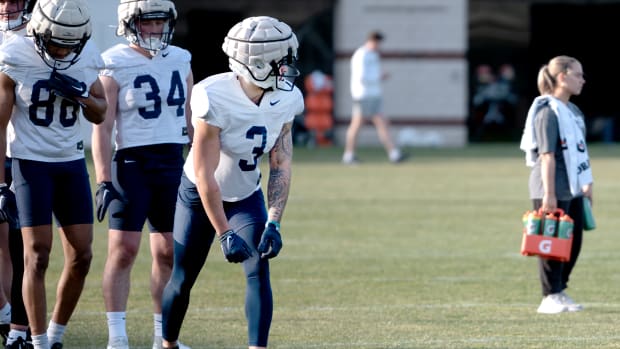College Sports Is Waiting for Signs From Notre Dame, but Independent Irish Can Afford to Wait
As we finish the long July 4th weekend, one question has moved to the forefront of the swirling speculation about the future of college athletics: Was this Notre Dame’s last Independence Day as an independent?
Since the jarring announcement last week that USC and UCLA are headed to the Big Ten in 2024, all is quiet beneath the Golden Dome. The longer it stays that way, the more one can surmise the Fighting Irish are weighing their biggest decision in decades. Maybe ever.
After the earth shifted again last Thursday, the next consideration has been the other attractive acquisition candidates available as the industry consolidates power into two conferences, the Big Ten and SEC. Notre Dame stands alone at the top of that list—as desirable as ever, and perhaps as vulnerable, too.
“The next decision,” one industry insider told Sports Illustrated, “really rests with Notre Dame.” That same person speculated the decision could come “in a week, or six months, or a year from now. We don’t know.”
It stands to reason the Big Ten would always take the object of its undying affection, now or sometime in the hazy future. It doesn’t matter if Notre Dame would be the 17th, 19th or 21st team in the league, the Big Ten would make it work to land the big prize it has chased for time immemorial. So the Irish can, as always, afford to be choosy and patient.
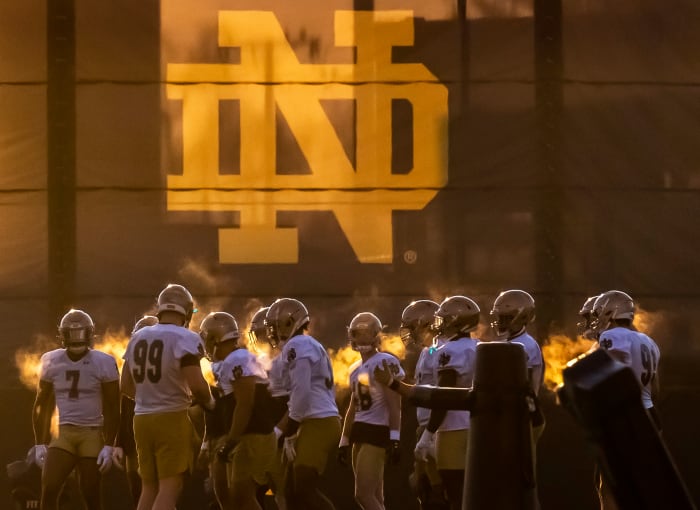
Notre Dame football recently played under the ACC during the COVID-19-shortened 2020 football season.
South Bend Tribune/USA TODAY Network
A source familiar with the school’s thinking told Sports Illustrated that “independence remains the preference and the leader in the clubhouse.” It will take a lot to move Notre Dame off its cherished identity, but the instability of the entire landscape remains a concern and could further affect the Irish outlook.
Two areas to monitor: the fates of both the College Football Playoff and the Atlantic Coast Conference. If one or both collapse, Notre Dame could be compelled into the Big Ten. Per its current contract, the playoff ceases to exist in January 2026. There is no guarantee another iteration of it will take its place, at any size. “The vast majority of the writing assumes a playoff, and that it’s going to get bigger,” says the industry source. “I’m not sure about that assumption.”
It’s possible the diminished Big 12 and Pac-12 could be frozen out. It’s possible the ACC also could be pushed aside. It’s possible the Big Ten and SEC each hold its own miniplayoffs, then the champions of the two leagues meet for a putative national title—or they don’t, and each conference can proclaim its superiority without settling it on the field. (If you want a lousy throwback to the lousy bowl system, this would be it.)
Notre Dame wants a path to a football national championship. If everything but the Big Ten and SEC is reduced to noncontender status, that could force them off Independence Island. Or, if the ACC splinters amid its long stay in a disadvantageous contract with ESPN, the school would have to think about its sports that compete in that league and might need to be relocated.
The school of thought for why it might finally be time for Notre Dame to join the Big Ten contains two classrooms: national scheduling and revenue.
One of the reasons the Irish have loved their independence is the ability to schedule their football games from coast to coast, appealing to a national fan constituency and recruiting philosophy (both athletic and academic); with ancient rival USC in the Big Ten fold along with UCLA, Notre Dame’s ability to play on the West Coast would remain annually viable. So would the East Coast, with Rutgers and Maryland. Plus, there is the core of “neighborhood” opponents the Irish have played regularly over the years in Purdue (87 meetings), Michigan State (79), Michigan (44) and Northwestern (49).
However, it seems highly likely the USC–Notre Dame series would continue without them being conference brethren. The number of schools that would turn down a chance to schedule Notre Dame likely will remain small no matter what.
In terms of revenue, which has become the dominant discussion point for everyone and everything in regards to realignment, Big Ten membership certainly would have its advantages. The league’s new media-rights contracts will be a money geyser raining down on member schools. A lot of people have theorized that Notre Dame would fall perilously far behind in that regard if it doesn’t join the conference. That might not be the case.
But don’t think for a minute the Irish are going to let money alone drive the decision on whether to abandon what has been a guiding principle since the school reached national prominence in football more than a century ago. The financial gap between maintaining independent status and Big Ten membership might well be considered manageable by the Notre Dame administration. This has never been an athletic department that operates with a budget the size of Texas’s or Ohio State’s, and likely doesn’t feel the need or desire to spend in the neighborhood of $200 million a year on sports.
That gets at the heart of the identity Notre Dame doesn’t want to relinquish: It is a one-of-a-kind football-academic-marketing powerhouse. It is the only school in the country that ranks in the top 20 of both the U.S. News & World Report’s national university rankings and NCAA football attendance. Notre Dame is 17th in the most recent academic rankings and has varied between 15th and 17th in home attendance from 2017 to ’21 (excluding ’20, when attendance was a worthless metric in college sports during the early months of the COVID-19 pandemic).
In numbers that resonate with TV executives, Notre Dame ranks eighth in the number of non-bowl/playoff games watched in recent seasons by at least three million people, per Sports Media Watch. The Irish had a total of 16 games with three million or more viewers in 2018, ’19 and ’21 (tossing ’20 numbers due to the disparity in number of games played across the nation). That ranks behind only Alabama (26), Ohio State (25), Georgia (22), Michigan (22), Oklahoma (22), Penn State (19) and LSU (18). It’s worth noting that every school ahead of Notre Dame on the list is a current or future member of the Big Ten or SEC. And the next four after the Irish are as well (Auburn, Wisconsin, Florida and Texas A&M).
Watch college football all season long with fuboTV: Start a 7-day trial today!
There are other smaller, private, academically prestigious schools that have had success in football, most notably Stanford and Northwestern in recent years. But they can’t match the size of Notre Dame’s following—they aren’t putting 75,000-plus butts in seats or parking three million of them in front of a screen.
Notre Dame has, forever, been able to have everything it wanted: academic prestige, football success, enough money to fund more than 20 competitive varsity sports—and the cherished autonomy of FBS independence. It won’t give up any of that willingly, even in a college sports world rocked by turbulence. The guess here is the school maintains its independence as long as it can, through July 4, 2023, and beyond.
That changes if the current structure only continues to destabilize in a profound way. Which, hey, could happen. While much of college sports is waiting for signs from Notre Dame, the school can afford to wait for signs from everyone else.
More Conference Realignment Reaction:


